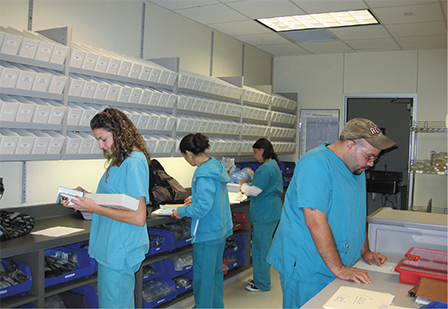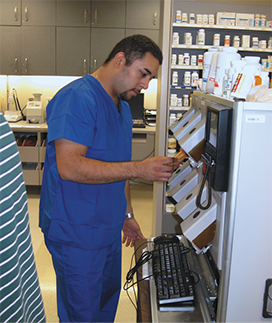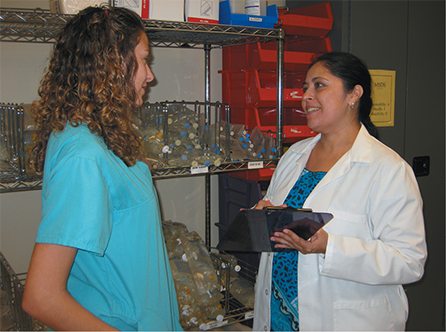11.2 The Hospital Pharmacy Department
Depending on the hospital size and specialization, hospital pharmacies provide a number of wide-ranging pharmaceutical products and services. The services fall into four categories: administrative (overseeing of the drug formulary, budget, inventory, and information); distribution (filling and delivering medications); clinical (consulting with and on patients); and educational (training pharmacists, technicians, patients, and the public).

Hospital pharmacy technicians often work at multiple workstations.
However, how these services are provided and to what depth and range vary considerably. Some of the variations among hospital pharmacies include the following:
the specialty services being offered and how they are offered
satellite or small pharmacies located within specific patient care units
clinical pharmacists making rounds with physicians and monitoring patients
consultation services for pharmacokinetics and individual patient dosing
pharmacy personnel staffing of a drug-information center
discharge pharmacy service versus outsourcing to a retail pharmacy
the medication distribution systems
medication delivery with unit dose cart exchange versus an automated floor stock system
frequency of unit dose cart exchanges (more than once daily, daily, or less often)
use of an automated or robotic dispensing system
centralized versus decentralized narcotic inventory control system
presence of an IV admixture program, including preparation of hazardous agents
in-house total parenteral nutrition (TPN) or nutrition service versus offsite preparation or outsourcing
the service availability (24 hours a day, 7 days a week, or less)
the pharmaceutical inventory processes, including those for the processing of bids, contracts, and purchase orders
the pharmacy protocol in providing medications and supplies in emergency codes
the instructional support for pharmacy residents and students
the procedures and measurements for safety, quality control, and productivity
 Pharm Fact
Pharm Fact
Hospitals have now incorporated scanning systems with bar code recognition for repackaging medications to reduce medication errors. Technicians have to place bar codes on medications that do not have them to work with the scanning system.
Several of these variations, including the range and processes of medication distribution systems and pharmaceutical inventory, are discussed later in this chapter.

Both small and large automation units are incorporated in hospital pharmacies to improve efficiency in carrying out the many diverse pharmacy responsibilities and to reduce medication errors.
Location and Structure
In a traditional hospital setting, the pharmacy department occupies a centralized location that is readily accessible to the emergency room/department and to the patient care units and surgical suites (or to the elevators leading to them). The pharmacy also needs to be in close proximity to a central storage area for bulk items such as boxes of IV solutions.
The interior layout of the pharmacy typically has several designated areas for different tasks: filling medication orders for individual patients, filling the medication carts, repackaging medications, and storing narcotics and investigational drugs, among other functions. The preparation of sterile and hazardous products occurs separately in a cleanroom or a hazardous compounding area.
Aside from the typical pharmacy equipment, hospital pharmacies usually have a unit dose cart for each care unit as well as repackaging equipment. Many large hospitals have incorporated robotic automation equipment for selecting and repackaging medications to improve efficiency and reduce medication errors. The cleanroom and the hazardous substance preparation areas have additional, large equipment for aseptic, sterile, and protective compounding (addressed in Chapters 12 and 13).
Director of Pharmacy
The hospital pharmacy staff is typically composed of a director of pharmacy, additional associate or assistant directors of pharmacy (for larger hospitals), pharmacists, and pharmacy technicians. Appointed by the CEO and hospital administrators, the director of pharmacy, also known as the pharmacist in charge (PIC), oversees the day-to-day and strategic operations of the department, such as managing the pharmacy budget; handling the staffing (hiring, evaluating, and firing of personnel); developing a strategic vision (long-term planning); complying with all federal and state regulations and laws; and establishing department policies and procedures with the P&T Committee to conform to the hospital’s overall policies and accreditation standards.
The director of pharmacy usually reports to a vice president of professional or patient care services (or similar title) and works closely with the director of nursing and the chief of staff in medicine to provide high-quality patient care.
Determining Pharmacy Services and Budget
The director determines the scope and level of pharmacy services based on available resources. The hospital’s overall annual budget determines the amount allocated to the pharmacy department for its budget, and the hospital’s budget is affected by patient census and government and insurance rates of reimbursements. Thus the pharmacy budget varies from year to year according to that of the hospital as a whole.
The director is responsible for projecting pharmacy needs and allocating funds for pharmaceuticals, staff, supplies, vendors, software, automation, and other needs. This annual projected budget is then submitted to the hospital administration for approval. The director is also in charge of implementing and monitoring the pharmacy budget that finally gets approved.
A vast majority of the budget must go to the purchase of pharmaceuticals. Drug budgets, in particular, can be difficult to predict, especially one to two years in advance. Newer, more expensive drugs or biotechnology advances are always coming into the marketplace, replacing lower-cost medical therapies and approaches. An example might be that a new transplant service is being implemented in the hospital that requires the use of new, expensive immunosuppressive drugs. Consequently, this will require a juggling of the current drug budget to free up the funds for these drugs or to find new sources for these budgetary funds. The director continually assesses the budgetary impacts of new drugs and hospital services.
The high costs of implementing state-of-the-art pharmacy software and automation technologies must also be calculated into the department budget, considering costs versus potential benefits, but these expenditures are more predictable and easier to plan.
 Pharm Fact
Pharm Fact
The ASHP Practice Advancement Initiative is being put in place most actively in hospitals, where pharmacists are taking more and more responsibility for patient health outcomes related to medications. The ASHP works to support this movement with resources, research, and case studies.
Determining Staffing and Resources
The pharmacy’s general budget and the amount allocated for drugs affect how much can be used for onsite staffing. Per day shift, a large city hospital may staff ten or more each of pharmacists and pharmacy technicians, with fewer on evening and night shifts. In addition, larger hospitals usually have pharmacy students, interns, and postgraduate residents.
In small, rural hospitals, there are fewer full-time pharmacists and technicians. Part-time pharmacists can make up the entire pharmacy staff, using “on-call” pharmacists for after-hours needs. No matter the size of the staff, the overall roles and responsibilities of the hospital pharmacy personnel remain the same.
Staffing decisions are based on the pharmacy’s dispensing rates and the projected bed occupancy numbers for the next year (or a select time period as well as hours of operation) and scope of services. Support personnel may include administrative support staff, part-time professional staff, and pharmacy students, interns, and residents. The hospital’s human resources department generally advertises for personnel positions and screens candidates. However, the director of pharmacy makes the final decision when pharmacy staff members are hired.
 Pharm Fact
Pharm Fact
Hospitals plan staffing based on their state requirements. Some hospitals can staff two technicians per one pharmacist or three to one, depending on their state regulations and whether or not the technicians are certified.
Though staffing needs are generally more predictable than drug budgets, they can also fluctuate in unplanned ways. For instance, if there is a local epidemic, this quickly escalates hospital use by the community, resulting in the need for more staff. Staffing decisions are also affected by space restrictions. Because of space and staff budget limitations, the director may outsource some medication preparation, distribution, or pharmacist clinical services. For example, a smaller hospital pharmacy may contract with an infusion pharmacy outside the hospital to formulate and deliver nutrition or hazardous drug products to the hospital. A hospital may also lease space to a local community pharmacy to provide outpatient pharmacy services within the hospital’s lobby or public space.
Overseeing the Policy and Procedure Manual
For a hospital to retain accreditation, each pharmacy department must have and follow an official Policy and Procedure (P&P) Manual. It outlines the mission of the department, its organizational components, and all the many policies and procedures for department operations with step-by-step instructions for both pharmacists and technicians. The director must see that the P&P Manual is implemented correctly and consistently and updated appropriately and frequently. The policies and procedures are drafted to fit all state and federal laws. The director of pharmacy may ask a technician to be involved in helping update the P&P Manual items directly related to pharmacy technicians. If you fail to follow the rules and processes of the P&P Manual, it may result in the termination of your employment.
Hospital Pharmacists
A large traditional or university hospital’s onsite pharmacy department is typically staffed 24 hours a day, 7 days a week with pharmacists and technicians. Hospital pharmacists oversee the accurate and safe dispensing of the medication orders. They also spend time advising hospital prescribers and nurses, and in clinical work consulting with patients and the healthcare teams for medication therapy management. The pharmacists who work in a hospital must have an extensive knowledge of the specific hospital formulary medications to provide thorough, expert drug consultations to the medical and nursing staff. For this reason, the pharmacists have a great responsibility to keep up to date on drugs moving through FDA approvals into the market, including high-potency injectable drugs and high-cost biotechnology drugs that are rarely, if ever, dispensed in a community pharmacy.
 Pharm Fact
Pharm Fact
A code blue emergency team usually consists of a physician who is the team leader, a critical care/ICU RN who leads until the physician arrives, a unit RN, a pharmacist, and a respiratory therapist. An emergency department technician may also be part of the team.
In addition, the lead code blue pharmacist must have the skills to prepare (and document) emergency medications that are needed in code blue emergency critical care situations. Hospital pharmacists typically wear name tags with their white lab coats so that they are easily recognizable for consultation in the hospital.
Major Pharmacist Responsibilities
The responsibilities of a hospital pharmacist include the following:
review medication histories of all newly admitted patients
verify medical drug orders in the computer
check medication orders against patient medical history and medication reconciliation alerts
visit patients and provide patient care services as part of a healthcare team (when assigned to a team)
verify medication cart fills, repackaging, and the preparation of sterile products
closely monitor controlled drug usage on each patient care unit
order and receive Schedule II controlled drugs
provide necessary drug information to prescribers and nurses
monitor automated robotic systems in the pharmacy and narcotic floor stock on patient care units
assist in cardiopulmonary resuscitation (CPR) codes by providing lifesaving drugs
dispense investigational drugs and complete the necessary documentation
provide medication education for patients soon to be discharged from the hospital
investigate medication error reports
provide quality control and productivity measurements within the department
represent the pharmacy department on select hospital committees as needed
 Practice Tip
Practice Tip
Many medical scientists are finding that different age groups, especially those of children, have different metabolism rates and organ effects. Some pediatric practices call for calculating dosages through additional formulas. That is why pediatric drug therapy is becoming a specialty for pharmacists and technicians.
Specializing Pharmacists
Many larger hospital pharmacies also have specialty-trained clinical pharmacists in internal medicine, emergency medicine, oncolocy, organ transplant, pediatrics, neonatal care, intensive care, surgery, nutrition, and pharmacokinetics. These specialists serve on healthcare teams that make daily rounds to visit or consult on patients. They may assist prescribers in ordering TPN solutions or offer recommendations in dosing high-risk medications. These clinical pharmacists work closely with the medical and nursing staff to resolve medication issues and improve the quality and safety of patient care. Some pharmacists specialize in compounding sterile products or chemotherapy and other hazardous drug compounding.

Hospital pharmacists are called in to consult on patient drug therapies as part of a healthcare team. The pharmacists’ clinical tasks can include visiting with patients and consulting with nursing teams and all the involved prescribers and specialists.
Hospital Pharmacy Technicians
The pharmacy technicians support the pharmacists (and the nurses) in preparing, packaging, and delivering the drugs to each nursing unit by filling the unit dose carts, stocking the automated central pharmacy and floor dispensing units, monitoring inventory and controlled substances in both the pharmacy and the nursing units, stocking the emergency crash cart, and, if trained, preparing sterile products. The drug types they dispense in the hospital are radically different from those used in the community pharmacy. Hospital drugs are generally more potent and targeted, and many are administered via the IV route of administration. Patients are often maintained on various IV fluids (with or without medications), IV nutrition solutions, and chemotherapy infusions.

The hospital pharmacy technician wears a particular colored scrub to be distinguished from the lab-coated pharmacists.
Work Environment
A hospital pharmacy setting is a more controlled work environment than a community pharmacy. Instead of handling patients at the counter, drive-through window, and on the phone, hospital pharmacy technicians have minimal interactions with the patients and the public. They communicate mainly with physicians, nurses, and other staff members via computer or phone. Most communications and medication orders are transmitted through the hospital software network.
Unlike in a community pharmacy, the pharmacy technician does not process insurance for each medication dispensed to a patient. The hospital’s billing department prepares and submits all the charges for each patient at discharge. The charges not being assumed by Medicare, Medicaid, Tricare, or private insurance (unless it is an HMO facility, where there will be no other insurers involved) are billed to the patient. The costs per dosage unit are far higher than at a community pharmacy because, instead of the community pharmacy’s small dispensing fee, the hospital adds a markup per drug to cover a portion of the overhead costs (including for pharmacy and nursing) for 24/7 care, which are substantial.
The pharmacy technicians typically wear name tags and scrubs or lab coats in a designated color to differentiate themselves from the pharmacists. This protocol for attire has been implemented by many hospitals in response to a need to quickly identify hospital personnel in the event of an emergency. Wearing pharmacy-designated uniform colors also helps identify pharmacy technicians who frequently deliver medications to patient care units.
 Pharm Fact
Pharm Fact
Because pharmacy technicians handle controlled substances, most healthcare facilities require technicians to wear security photo ID badges along with all the rest of the healthcare workers.
In addition, all pharmacy personnel must follow the same hygiene and infection control procedures used by the rest of the healthcare staff for personnel and patient safety (addressed in Chapter 12, Infection Control, Aseptic Technique, and Cleanroom Facilities). For technicians who serve in the hospital cleanroom, additional processes and garbing elements are required for aseptic technique (also covered in the next chapter).
Technician Training and Orientation
Because of the complex environment of a hospital pharmacy department, the learning curve for technicians may be three months or longer to develop the necessary skills. Many large, urban hospitals will hire only certified technicians who have graduated from an American Society of Health-System Pharmacists (ASHP)-accredited training program who bring with them hospital experience. All technicians must pass criminal background checks (like other pharmacy personnel) due to access to potent narcotic drugs. To keep up with new drug and policy changes, the department requires frequent all-staff informational sessions with mandatory annual retraining.
 Pharm Fact
Pharm Fact
The University of Wisconsin Hospital and Clinics, Cedars-Sinai Medical Center (Los Angeles), and Long Beach Memorial Medical Center have all implemented tech-check-tech (TCT) programs and recorded > 99.8% accuracy rate for trained and certified technicians filling unit dose delivery carts. This rate is comparable to pharmacists’ rates.
To maintain flexibility in scheduling, each technician generally goes through training to perform all major department functions. They rotate through these functions during their orientation and training. However, most pharmacy technicians do not rotate through the cleanroom or hazardous compounding area without specialized training.
Technician Advancement and Specializations
Though the technicians rotate in the general pharmacy, they often end up specializing in one area, such as medication reconciliation, unit dose filling, managing robotics, maintaining floor stock, managing inventory control, staff training, or sterile compounding. In larger hospitals, there are often different grade levels among the pharmacy technicians, allowing technicians to advance in responsibilities and pay depending on their skills and experience.
For example, in some hospital pharmacies, a senior pharmacy technician may be given additional administrative responsibilities, such as supervising other technicians in their daily responsibilities. This is the tech-check-tech (TCT) function, where a senior technician checks another technician’s work. This adds another layer of safety verification to the process of medication ordering. State boards of pharmacy have authorized TCT programs in at least nine states.
To encourage the technician staff to continually develop their capabilities, many large hospital corporations have developed their own formalized certification programs, especially in the areas of sterile and hazardous drug compounding. Since the medications and supplies needed on a surgery nursing unit will be much different from those on a pediatric one, a pharmacy technician may become specifically trained and assigned to a decentralized specialty satellite unit. For example, a certified technician with time and experience can become a valuable resource in a specialty nursing unit.